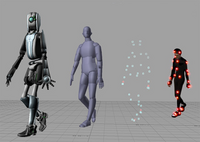
Photo from wikipedia
OBJECTIVES To investigate the diagnostic value of magnetic resonance imaging (MRI)-based 3D texture and shape features in the differentiation of glioblastoma (GBM) and primary central nervous system lymphoma (PCNSL). PATIENTS… Click to show full abstract
OBJECTIVES To investigate the diagnostic value of magnetic resonance imaging (MRI)-based 3D texture and shape features in the differentiation of glioblastoma (GBM) and primary central nervous system lymphoma (PCNSL). PATIENTS AND METHODS A total of eighty-two patients, including sixty patients with GBM and twenty-two patients with PCNSL were followed up retrospectively from January 2012 to September 2017. MRI-based 3D texture and shape analysis were performed to evaluate the detectable differences between the two malignancies. The performance of machine-learning models was assessed. The Mann-Whitney U test and receiver operating characteristic (ROC) analysis were performed, and the corresponding sensitivity, specificity, accuracy, and area under the curve (AUC) were calculated. Ultimately, 60 GBM patients (33 males, 27 females; mean age 51.55 ± 13.58 years, range 8-74 years) and 22 PCNSL patients (14 males, 8 females; mean age 55.18 ± 12.19 years, range 32-78 years) were included in this study. All the PCNSLs were of the diffuse large B-cell type, and all patients were immunocompetent. RESULTS The variables Firstorder_Skewness, Firstorder_Kurtosis, and Ngtdm_Busyness, representing features extracted from contrast-enhanced T1-weighted images, showed high discriminatory power. Firstorder_ Skewness was the best selected predictor for classification (AUC = 0.86), followed by Ngtdm_Busyness (AUC = 0.83) and Firstorder_Kurtosis (AUC = 0.80). The sensitivities and specificities ranged from 70.0% to 83.3% and from 71.4% to 90.5%, respectively. Among three classification models, the naive Bayes classifier was superior overall, with a high AUC (0.90) and the best specificity (0.91). The support vector machine models provided the best sensitivity and accuracy (0.92 and 0.88, respectively). CONCLUSIONS MRI-based 3D texture analysis has potential utility for preoperative discrimination of GBM and PCNSL.
Journal Title: Clinical Neurology and Neurosurgery
Year Published: 2018
Link to full text (if available)
Share on Social Media: Sign Up to like & get
recommendations!